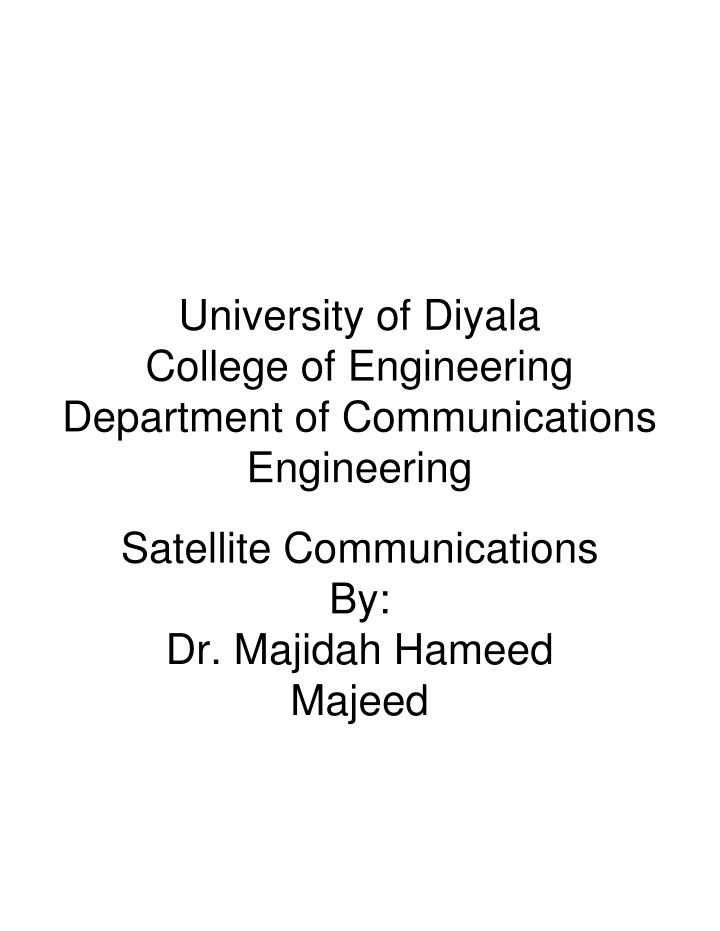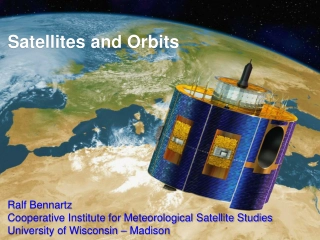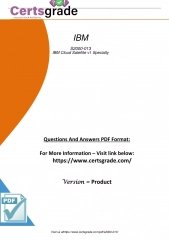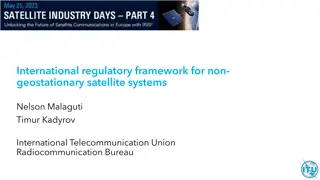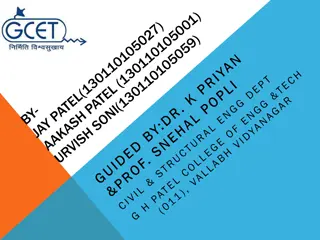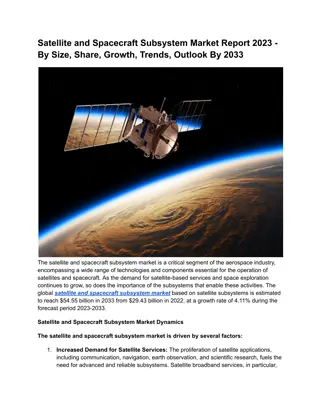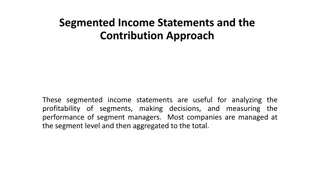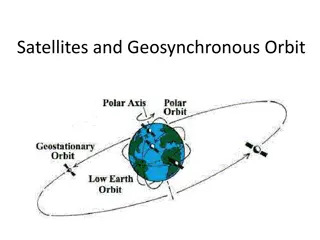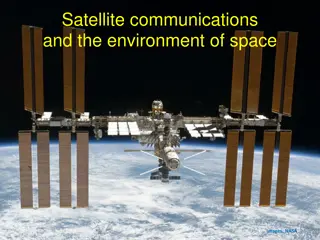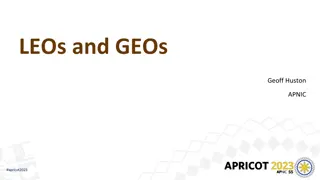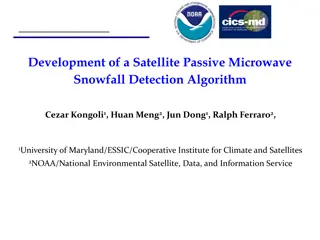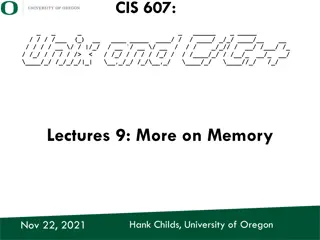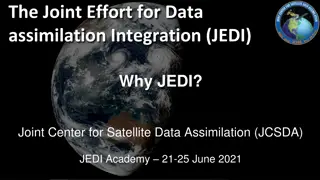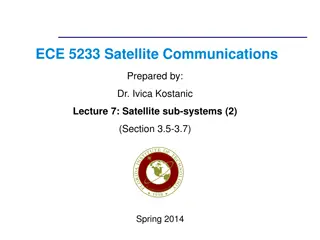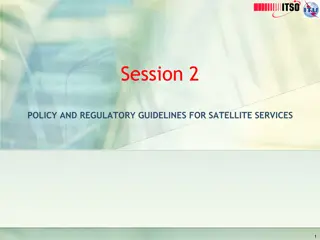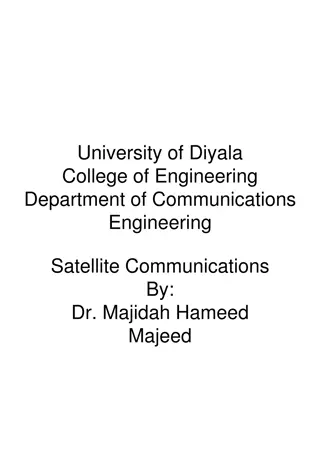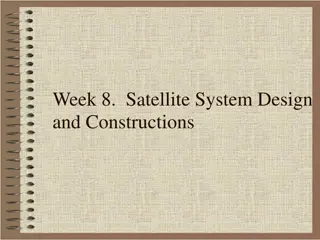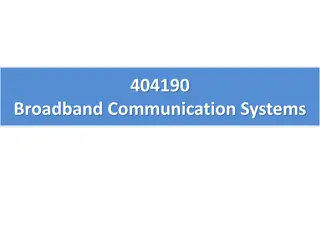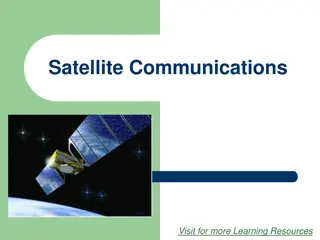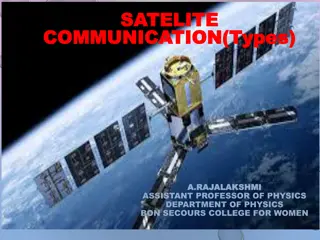Satellite Communications in Earth Segment
The Earth Segment in satellite communications involves systems on Earth managing spacecraft and data, including TVRO services and tracking functions.
Download Presentation

Please find below an Image/Link to download the presentation.
The content on the website is provided AS IS for your information and personal use only. It may not be sold, licensed, or shared on other websites without obtaining consent from the author.If you encounter any issues during the download, it is possible that the publisher has removed the file from their server.
You are allowed to download the files provided on this website for personal or commercial use, subject to the condition that they are used lawfully. All files are the property of their respective owners.
The content on the website is provided AS IS for your information and personal use only. It may not be sold, licensed, or shared on other websites without obtaining consent from the author.
E N D
Presentation Transcript
University of Diyala College of Engineering Department of Communications Engineering Satellite Communications By: Dr. Majidah Hameed Majeed
3.3 The Earth Segment The Ground Segment is the set of systems deployed on the earth to manage and control both the spacecraft and its payloads. For Earth Observation and Scientific missions, a payload data ground segment receives and processes the data produced by the instruments on-board the satellite and archives and distributes the resulting products to external users ground generated products. It is the essential bridge between the spacecraft and its end-users. The earth segment of a satellite communications system consists of the transmit and receive earth stations. Included as follow:- - TV receive-only (TVRO) - BS for international communications networks. - BS for ships, commercial, military land and aeronautical mobile stations. a. TV receive-only (TVRO) Planned broadcasting directly to home TV receivers takes place in the Ku (12GHz) band. This service is known as Direct Broadcast Satellite (DBS) service. There is some variation in the frequency bands assigned to different geographic regions. Fig 3.8 shows the main units in a home terminal DBS TV receiving system the diagram covers the basic concept for analog (FM) TV. b. The outdoor unit : This consists of: 1- Receiving Antenna: A parabolic reflector is generally used, with the receiving horn mounted at the focus. Depending on design there are two type : -Front Feed Parabolic antenna:- in this type the focus directly in front of the reflector as shown in fig 3.9 (a) - Offset Feed Parabolic antenna:- by used this type we get better interference rejection as shown in fig 3.9 (b) 10
Fig 3.8 DBS TV system b-Offset Feed Parabolic antenna a-Front Feed Parabolic antenna fig 3.9 11
We can calculate the Gain of reflector antenna as follow Where ?: is overall efficiency is typically within the range 55% to 75% D: diameter of the reflector 2- Low-Noise-Block LNB:- it is a combination unit consisting of a lownoise amplifier LNA followed by a converter. It is provide gain for the broadband signal and then converts the signal to a lower frequency range so that a low-cost coaxial cable can be used as feeder to the indoor unit. The standard frequency range of this down converted signal is 950 to 1450 MHz. 3.10 3.1.6 Tracking, Telemetry, Command, and Monitoring (TTC&M) The tracking, telemetry, command, and monitoring (TTC&M) subsystem provides essential spacecraft management and control functions to keep the satellite operating safely in orbit as shown in fig ( 3.11). The TTC&M links between the spacecraft and the ground are usually separate from the communications system links. TTC&M links may operate in the same frequency bands or in other bands Figure 3.10 shows the typical TTC&M functional elements for the satellite and ground facility for a communications satellite application 12
Figure 3.11 The satellite TTC&M subsystems comprise *The antenna *Command receiver *Tracking and telemetry transmitter, *Tracking sensors. The elements on the ground include the TTC&M antenna,telemetry receiver, command transmitter, tracking , subsystem, and associated processing and analysis functions. Satellite control and monitoring is accomplished through monitors and keyboard interface Telemetry data are received from the other subsystems of the spacecraft, such as the payload, power, attitude control, and thermal control. Command data are relayed from the command receiver to 13
other subsystems to control such parameters as antenna pointing, transponder modes of operation, battery and solar cell changes, etc The tracking function is accomplished by a number of techniques, usually involving satellite beacon signals, which are received at the satellite TTC&M earth station . *The telemetered data include following parameters: -Voltage and current conditions in the power subsystem, -Temperature of critical subsystems, -Status of switches and relays in the communications and antenna subsystems, -Fuel tank pressures, and attitude control sensor status.is the complementary function to telemetry. The command system relays specific control and operations information from the ground to the spacecraft. *The command system is used during launch to control the firing of the boost motor, deploy appendages such as solar panels and antenna reflectors, and spin-up a spin-stabilized spacecraft body. *Security is an important factor in the command system for a communications satellite. 14
